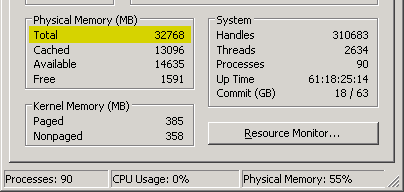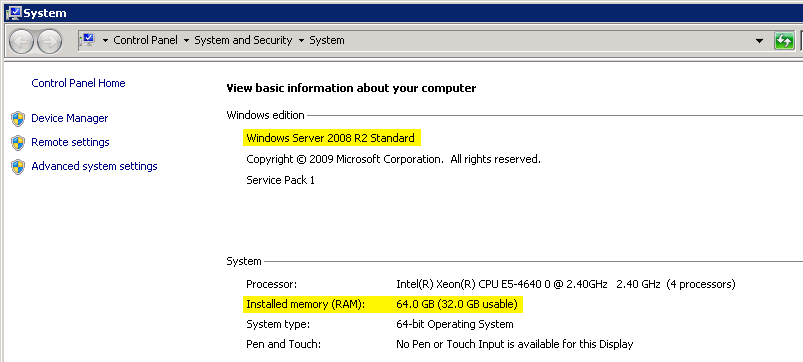#PSTip How to identify “memory limited” servers using PowerShell
Note: This tip requires PowerShell 2.0 or above.
Yesterday, I got a call from one of our BI managers. Listen, he says, I suspect that one of my BI servers is working too hard. It’s a physical server with 64GB of RAM and I think it doesn’t utilize all of its memory.
We were able to determine that the installed OS was actually a wrong one. We had Server 2008 R2 installed, and according to this article, Standard editions (of 2008 R2) are limited to 32GB. I took a quick look the values in Task Manager and I could verify that the total memory was 32GB.

A second look at the system properties page confirmed the above.

With that, I continued to the next step of upgrading the servers to Enterprise edition. Luckily I did not have to re-install the server. I followed this article and used DISM for the upgrade. Using the following script I found 3 more servers in my environment that had more physical memory than the OS could see.
$computers = Get-ADComputer -Filter {OperatingSystem -like "*standard*"} -Properties OperatingSystem | Select-Object Name,OperatingSystem
foreach($computer in $computers)
{
if(Test-Connection -ComputerName $computer.Name -Count 1 -Quiet)
{
$total = (Get-WmiObject Win32_PhysicalMemory -ComputerName $computer.Name | Measure-Object Capacity -Sum).Sum/1GB
$visible = (Get-WmiObject Win32_OperatingSystem -ComputerName $computer.Name).TotalVisibleMemorySize/1MB
if( ($total-$visible) -gt 2)
{
New-Object PSObject -Property @{
Name = $computer.Name
OS = $computer.OperatingSystem
Memory = $total
Visible = $visible
}
}
}
}
The code get’s all standard servers from AD and checks if the total amount of RAM is larger, by 2GB, from the amount of visible ram. The result of TotalVisibleMemorySize does not give absolute numbers. You might get 31.7 when you have 32GB of RAM. So a difference of 2GB will filter out all those “almost” values.
Share on: